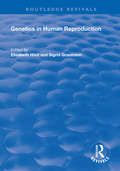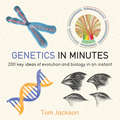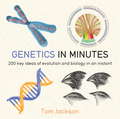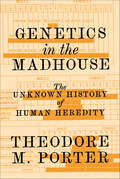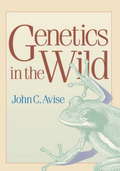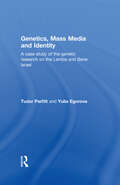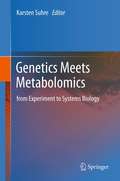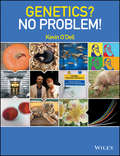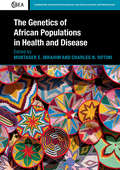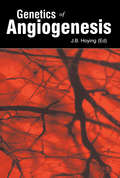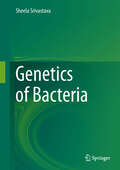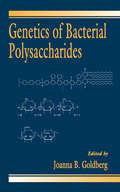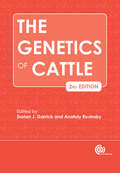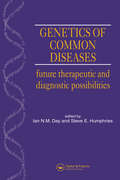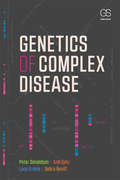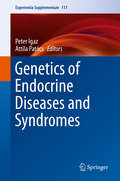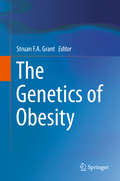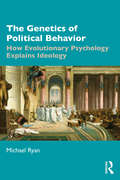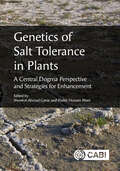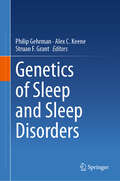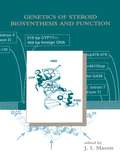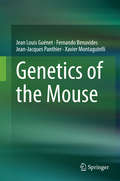- Table View
- List View
Genetics in Human Reproduction (Routledge Revivals)
by Elisabeth Hildt Sigrid GraumannPublished in 1999, this book discusses issues related to the current and possible future technological progress in genetic technology linked to in vitro fertilization, specifically preimplantation diagnosis and germline gene therapy, from a scientific and medical as well as from a social, juridical and ethical point of view. The 31 contributions are divided into six sections medical and scientific view, personal interests and moral implications, moral rights and duties, social concepts and moral implications, choices and decision making, and justice in health care and legal regulation.
Genetics in Minutes (In Minutes)
by Tom JacksonGenetics in Minutes is your compact and accessible guide to the central concepts of the science of genetics, revealing how our genes shape our bodies and our lives, and how in turn we are beginning to shape them. Covering the basics of DNA, inheritance and evolution in animals, plants and humans alike -from the origins and development of life to the Human Genome and designer babies - this is the fastest, fullest path to understanding genetics. Contents include Genes, DNA, Natural selection, Darwinism, Stem cell and gene therapies, Evo-devo, Epigenetics, Cloning, Genetic engineering and Artificial life, as well as biology basics such as the Processes of life, Cells, Sex, Classification and Ecology.
Genetics in Minutes (IN MINUTES)
by Tom JacksonGenetics in Minutes is your compact and accessible guide to the central concepts of the science of genetics, revealing how our genes shape our bodies and our lives, and how in turn we are beginning to shape them. Covering the basics of DNA, inheritance and evolution in animals, plants and humans alike - from the origins and development of life to the Human Genome and designer babies - this is the fastest, fullest path to understanding genetics. Contents include Genes, DNA, Natural selection, Darwinism, Stem cell and gene therapies, Evo-devo, Epigenetics, Cloning, Genetic engineering and Artificial life, as well as biology basics such as the Processes of life, Cells, Sex, Classification and Ecology.
Genetics in Minutes
by Tom JacksonGenetics in Minutes is your compact and accessible guide to the central concepts of the science of genetics, revealing how our genes shape our bodies and our lives, and how in turn we are beginning to shape them. Covering the basics of DNA, inheritance and evolution in animals, plants and humans alike - from the origins and development of life to the Human Genome and designer babies - this is the fastest, fullest path to understanding genetics. Contents include Genes, DNA, Natural selection, Darwinism, Stem cell and gene therapies, Evo-devo, Epigenetics, Cloning, Genetic engineering and Artificial life, as well as biology basics such as the Processes of life, Cells, Sex, Classification and Ecology.
Genetics in the Madhouse: The Unknown History of Human Heredity
by Theodore M. PorterThe untold story of how hereditary data in mental hospitals gave rise to the science of human heredityIn the early 1800s, a century before there was any concept of the gene, physicians in insane asylums began to record causes of madness in their admission books. Almost from the beginning, they pointed to heredity as the most important of these causes. As doctors and state officials steadily lost faith in the capacity of asylum care to stem the terrible increase of insanity, they began emphasizing the need to curb the reproduction of the insane. They became obsessed with identifying weak or tainted families and anticipating the outcomes of their marriages. Genetics in the Madhouse is the untold story of how the collection and sorting of hereditary data in mental hospitals, schools for "feebleminded" children, and prisons gave rise to a new science of human heredity.In this compelling book, Theodore Porter draws on untapped archival evidence from across Europe and North America to bring to light the hidden history behind modern genetics. He looks at the institutional use of pedigree charts, censuses of mental illness, medical-social surveys, and other data techniques--innovative quantitative practices that were worked out in the madhouse long before the manipulation of DNA became possible in the lab. Porter argues that asylum doctors developed many of the ideologies and methods of what would come to be known as eugenics, and deepens our appreciation of the moral issues at stake in data work conducted on the border of subjectivity and science.A bold rethinking of asylum work, Genetics in the Madhouse shows how heredity was a human science as well as a medical and biological one.
Genetics in the Wild
by John C. AviseAward-winning geneticist John C. Avise guides this delightful voyage around the planet in search of answers to nature's mysteries. He demonstrates how scientists directly examine DNA to address long-standing questions about wild animals, plants, and microbes. Through dozens of stories that span the world, nature emerges as a realm where truth can be far stranger than fiction. From a 100-ton mushroom to egg-swapping birds, extinct ground sloths to microbes inside our bodies, Avise examines a cornucopia of natural-history topics and explains how today's modern genetic techniques offer novel insights. Do armadillo litters really contain clones? When is a fig tree not just a single tree? Where have migratory whales traveled? Who are the mothers of the embryos carried by pregnant male seahorses? What insect was the world's earliest farmer? How closely related are Neanderthals to modern humans? Answers to these and many more questions are presented here in a straightforwad manner that reveals Avise's enthusiasm for uncovering nature's hidden ways. Each entry is accompanied by a beautiful illustration from Trudy Nicholson, widely recognized as one of today's leading nature artists.
Genetics, Mass Media and Identity: A Case Study of the Genetic Research on the Lemba
by Tudor Parfitt Yulia EgorovaThis is the first book to explore the effect of genetic research on the Lemba Judaising community of Southern Africa and the phenomenon of Israelite identity. The science of genetics as relayed by the media is perceived by laymen as being irreproachably objective 'hard science': its disinterested 'scientific' findings appear immensely impressive and may therefore act as a powerful catalyst for change. In this case, an oral tradition cherished by many of the Lemba that they are of Jewish origin appears to be supported by recent DNA testing, which has deeply affected the narrative and religious identity of the group and the way the tribe is perceived in the Western world. International in appeal, this topical text brings together cutting-edge research on the social, cultural and ethical implications of genetics and the study of Judaising movements across the world. This book will be of interest to researchers and students of Jewish history, genetic anthropology, race and ethnicity studies, and religious and cultural studies.
Genetics Meets Metabolomics
by Karsten SuhreThis book is written by leading researchers in the fields about the intersection of genetics and metabolomics which can lead to more comprehensive studies of inborn variation of metabolism.
Genetics? No Problem!
by Kevin O'DellThe analysis and interpretation of data is fundamental to the subject of genetics and forms a compulsory part of the undergraduate genetics curriculum. Indeed, the key skills that a genetics student requires are an ability to design and understand experimental strategies and to use problem-solving skills to interpret experimental results and data. Genetics? No Problem! provides students with a graded set of problems that aim to enthuse, challenge and entertain the reader. The book is divided into three sections – introductory; intermediate and advanced – each with 10 problems. For first level students there will be short genetics problems embedded in a wide range of scenarios, such as murder mysteries. As the book progresses, the stories will get longer and the science will get progressively more complex to challenge final year students and enable the reader to identify genetic disease in obscure organisms as well as designing and testing treatments and cures. Genetics? No Problem!: Takes a unique, innovative approach that provides students with a set of graded problems designed to develop both their skills, and their ability to tackle problems with confidence Includes problems embedded in a narrative, written in an interesting, informative and entertaining style by an Author with a proven track record in teaching, research and communication Is well illustrated in full colour throughout. The book will prove invaluable to all students of genetics across a range of disciplines needing to get to grips with the analysis and interpretation of data that is fundamental to the subject.
The Genetics of African Populations in Health and Disease (Cambridge Studies in Biological and Evolutionary Anthropology #84)
by Muntaser E. Ibrahim Charles N. RotimiThe birthplace of modern humans, Africa, has the highest genetic diversity in the world, yet it remains vastly understudied. With biomedical research increasingly focused on human variation, studying the large population size and number of mutations in African genomes could unravel the complexity of phenotypic traits underlying the biology of our species and hold huge potential for scientific and medical advances. An initial chapter 'conceptualizes Africa', providing relevant terminology. The first section covers genetic history and population structure. The next section looks at the genetic basis of common infectious diseases, such as leishmaniasis, malaria and tuberculosis, with a final part considering common non-communicable diseases, such as diabetes, hypertension, obesity, heart disease and cancer. Gene environment interaction under globalization and the burden of diseases of lifestyle are included. For researchers and graduate students in biological anthropology, genetic anthropology, human and population genetics, and public health.
Genetics of Angiogenesis
by James HoyingAngiogenesis research is one of the most quickly developing areas in biomedicine. It is considered to be a common denominator in society's most important diseases and pharmaceutical companies are racing to develop new angiogenesis-based drugs.This volume focuses on the genetic control of angiogenesis, both in humans and model organisms, and will be a valuable resource to all researchers in the field, including the fundamentals of the process as well as workers in biotechnology.
Genetics of Bacteria
by Sheela SrivastavaDescribed as the earliest, simplest life forms, with unlimited metabolic versatility, bacteria are ideally suited to answer some very fundamental questions on life and its processes. They have been employed in almost all fields of biological studies, including Genetics. The whole edifice of science of Genetics centers around three processes: the generation, expression, and transmission of biological variation, and bacteria offer immediate advantages in studying all the three aspects of heredity. Being haploid and structurally simple, it becomes easy to isolate mutations of various kinds and relate them to a function. The availability of such mutants and their detailed genetic and biochemical analyses lead to a gamut of information on gene expression and its regulation. While studying the transmission of biological variation, it is clear that unlike their eukaryotic counterpart, a more genetic approach needs to be employed. Transmission of genetic information in most eukaryotic organisms rests on sexual reproduction that allows the generation of genetically variable offspring through the process of gene recombination. Even though bacteria show an apparent preference for asexual reproduction, they too have evolved mechanisms to trade their genetic material. In fact, bacteria not only could acquire many genes from close relatives, but also from entirely distant members through the process of horizontal gene transfer. Their success story of long evolutionary existence will stand testimony to these mechanisms. While teaching a course on Microbial Genetics to the post-graduate students at Delhi University, it was realized that a book devoted to bacterial genetics may be very handy to the students, researchers, and teachers alike. A strong foundation in genetics also helps in comprehending more modern concepts of molecular biology and recombinant DNA technology, always a favorite with the students and researchers. Planning the format of the book, emphasis has been laid on the generation and transmission of biological variability. The omission of expression part is indeed intentional because lots of information is available on this aspect in any modern biology book. The contents are spread over seven chapters and the text is supported with figures/tables wherever possible. The endeavor has been to induce the readers to appreciate the strength of bacterial genetics and realize the contribution of these tiny organisms to the growth of biological sciences as a whole and genetics in particular.
Genetics of Bacterial Polysaccharides
by Joanna B. GoldbergBacterial surface or secreted polysaccharides are molecules that can function as barriers to protect bacterial cells against environmental stresses, as well as act as adhesins or recognition molecules. In some cases, these molecules are immunodominant antigens eliciting a vigorous immune response, while in other cases the expression of polysacchari
Genetics of Cattle, The
by Dorian J. Garrick Anatoly RuvinskySince the time of domestication more than 10,000 years ago, cattle have played an increasingly crucial role in the development of human civilizations. Progress has been quite remarkable since the turn of the century; the sequencing of the bovine genome in 2009 launched new avenues for furthering our understanding of theoretical and practical aspects of cattle genetics. Covering a vast array of questions, this book reviews major topics from molecular and developmental genetics, disease resistance and immunogenetics to genetic improvement of dairy and beef breeds, addressing all current problems in the field. This second edition includes a new team of authors and completely new chapters on the genetics of fat production, nutrition, feed intake and efficiency, growth and body composition. Fully updated throughout, it provides a valuable resource on cattle genetics for researchers, breeders, veterinarians and postgraduate students.
Genetics of Common Diseases: Future Therapeutic and Diagnostic Possibilities
by Ian N.M. Day and Steve E. HumphriesMany common diseases are partly attributable to the genes which an individual inherits. Early steps have now been made in developing ways to determine which genetic variations are important, with some recent successes. This is a collection of papers from the Fifth Annual Molecular Pathology Symposium on the 10 December 1996. They represent the contributions to that meeting made by a set of distinguished scientists and clinicians whose work pertains to the furtherment of our understanding of the genetic components of common diseases and potential future approaches.
Genetics of Complex Disease
by Peter Donaldson Ann Daly Luca Ermini Debra BevittGenetics of Complex Disease is a concise text for final year undergraduate and first year graduate students. Healthcare professionals and other biomedical scientists trying to come to grips with the impact of new genetics research will also find the book useful. After explaining genetic variation and defining complex diseases, the text shows how and why complex diseases are investigated. The focus then changes to areas where there is strong evidence for the genes/alleles involved. Important ethical consequences are also covered, as are the methods used to generate new genetic data.
Genetics of Endocrine Diseases and Syndromes (Experientia Supplementum #111)
by Peter Igaz Attila PatócsThis book provides a comprehensive overview of the genetic basis underlying endocrine diseases. It covers both the molecular and clinical consequences of these genetic defects, as well as the relevance for clinical care, highlighting issues of genetic counseling. Several endocrine diseases have a genetic background, and contemporary research in the field plays a crucial role in the clinical care of endocrine diseases. In recent years, there have been major developments in our understanding of the genetic basis of endocrine diseases. Several novel genes and mutations predisposing individuals to monogenic endocrine diseases have been discovered, and with the advent of next generation sequencing, a huge amount of new data has become available. Further, novel molecular mechanisms, such as genomic imprinting, have been implicated in the pathogenesis of endocrine diseases.A better understanding of the genetic background of these diseases is relevant not only from the research perspective, but also in terms of clinical care. As such, this book is an essential read for both researchers and clinicians working in the field.
Genetics of Mental Disorders: What Practitioners and Students Need to Know
by Stephen V. Faraone Ming T. Tsuang Debby W. TangIntroduces ideas about inherited genetically based mental disorders and how they combine with environmental factors. thinks about mental disorders with insight.
The Genetics of Obesity
by Struan F.A. GrantIn the past four years, many genetic loci have been implicated for BMI from the outcomes of genome-wide association studies (GWAS), primarily in adults. Insulin-induced gene 2 (INSIG2) was the first locus to be reported by this method to have a role in obesity but replication attempts have yielded inconsistent outcomes. The identification of the second locus, the fat mass- and obesity-associated gene (FTO), h has been more robustly observed by others. Studies from both FTO knock out and FTO overexpression mouse model support the fact that FTO is directly involved in the regulation of energy intake and metabolism in mice, where the lack of FTO expression leads to leanness while enhanced expression of FTO leads to obesity. Along with numerous other studies, a number of genetic variants have been established robustly in the context of obesity, giving us fresh insights into the pathogenesis of the disease. This book will give a comprehensive overview of efforts aimed at uncovering genetic variants associated with obesity, which have been particularly successful in the past 5 years with the advent of genome-wide association studies (GWAS). This book will cover this state of the art technology and its application to obesity in great detail. Topics covered will include genetics of childhood obesity, genetics of syndromic obesity, copy number variants and extreme obesity, co-morbidities of obesity genetics, and functional follow-up of genetic variants.
Genetics of Original Sin: The Impact of Natural Selection on the Future of Humanity
by Christian De Duve Neil PattersonIncreasingly absorbed in recent years by advances in our understanding of the origin of life, evolutionary history, and the advent of humankind, eminent biologist Christian de Duve of late has also pondered deeply the future of life on this planet. He speaks to readers with or without a scientific background, offering new perspectives on the threat posed by humanity's immense biological success and on the resources human beings have for altering their current destructive path. Focusing on the process of natural selection, de Duve explores the inordinate and now dangerous rise of humankind. His explanation for this self-defeating success lies in the process of natural selection, which favors traits that are immediately useful, regardless of later consequences. Thus, the human genome determines such properties as tribal and group cohesion and collaboration and often fierce and irrational competition with and hostility toward other groups' attributes that were once useful but now often ruinously dysfunctional. Christian de Duve suggests that these traits, imprinted into human nature by natural selection, may have been recognized by the writers of Genesis, thus inspiring the myth of original sin. Is there redemption for genetic original sin? In a brilliant and original conclusion, the author argues that, unique in the living world, humankind is endowed with the ability to deliberately oppose natural selection. Human beings have the capacity to devise measures that, while contrary to local or personal interests, can bring forth a safer world.
The Genetics of Political Behavior: How Evolutionary Psychology Explains Ideology
by Michael RyanIn this unique amalgam of neuroscience, genetics, and evolutionary psychology, Ryan argues that leftists and rightists are biologically distinct versions of the human species that came into being at different moments in human evolution. The book argues that the varying requirements of survival at different points in history explain why leftists and rightists have anatomically different brains as well as radically distinct behavioral traits. Rightist traits such as callousness and fearfulness emerged early in evolution when violence was pervasive in human life and survival depended on the fearful anticipation of danger. Leftist traits such as pro-sociality and empathy emerged later as environmental adversity made it necessary for humans to live in larger social groups that required new adaptive behavior. The book also explores new evolutionary theories that emphasize the role of the environment in shaping not only human political behavior but also humans' genetic architecture. With implications for the future of politics, the book explores how the niche worlds we build for ourselves through political action can have consequences for the evolution of the species. Proposing a new way of understanding human politics, this is fascinating reading for students and academics in psychology, the social sciences, and humanities, as well as general readers interested in political behavior.
Genetics of Salt Tolerance in Plants: A Central Dogma Perspective and Strategies for Enhancement
by Kehinde A. Adeboye Victor J. Bamisaye Farwa Basit Usman Rabi’u Bello Javaid Akhter Bhat Jamindar Buddiga Utpal Das Balasundari Dharbaranyam Xianzhong Feng M. Gayathri Abubakar Mohammad Gumi Md Sazzad Hossain Emmanuel O. Idehen Krishnananda P. Ingle Nancy McMulkin Mushtaq Ahmad Najar Oyeboade A. Oyetunde Kapil Patil Britta Pitann Shiva Sai Prasad Fergie Ann Quilloy Md Zillur Rahman J. R. Rajeshwar P. W. Ramteke Hamza Ramzan Vincent Pamugas Reyes Kausalya Sakthivel Palanisamy Senthilmurugan Usama Sheraz Sajid Shokat Pradeep Kumar Shukla Atul Singh Gayatri Venkataraman Mst Ishrat ZahanGene expression in cells follows a prescribed pathway that conforms to the Central Dogma; where the genetic information stored in DNA is transcribed into RNA and then expressed into proteins, which influences most plant traits. Plant salt tolerance research is directed towards identifying nucleotide variants that could contribute to tolerant phenotypes. This book comprehensively presents the current state of knowledge on plant salt tolerance through meticulous analysis of the processes operating across the Central Dogma. It provides a detailed account of modulation of gene expression through genome editing systems to achieve crop improvement against salt stress. It also provides state-of-the-art information on advances in breeding technologies of genome selection and accelerated de novo domestication for rapidly improving the salt tolerance of plants for global food security. This book: 1.Provides a comprehensive coverage of plant salt tolerance mechanisms. 2.Spotlights various factors functioning along the Central Dogma pathway and their regulation in response to salinity. 3.Examines how these factors function to protect the plants from high salinity. 4.Highlights advances in cutting-edge breeding technologies for improving salt tolerance. The book will be of particular value to students and researchers of plant genetics, molecular biology and physiology and those with an interest in salinity and salt tolerance.
Genetics of Sleep and Sleep Disorders
by Philip Gehrman Alex C. Keene Struan F. GrantThis book focuses on the latest research on the genetic basis of the regulation of sleep and wakefulness and of sleep and circadian rhythm disorders, which has been expanding rapidly due to advances in genetics. The book reviews the latest genetic discoveries in animals and humans and explores their implications for getting a good night's sleep. Philp Gehrman, Alex Keene, Struan Grant, and a cadre of top sleep researchers and clinicians explore the genetics of sleep and sleep disorders in depth. The book should appeal to sleep medicine specialists, psychiatrists, geneticists, and neuroscientists.
Genetics of Steroid Biosynthesis and Function (Modern Genetics Ser.)
by J. I. MasonSteroids are among the most widely prescribed drugs for humans, and steroid signaling pathways are present in vertebrates, plants, insects and fungi, presenting new avenues for biotechnological intervention. Genetics of Steroid Biosynthesis and Function focuses on the genetic and cellular aspects of mammalian steroid hormones with particular attent
Genetics of the Mouse
by Jean Louis Guénet Fernando Benavides Jean-Jacques Panthier Xavier MontagutelliThis book, written by experienced geneticists, covers topics ranging from the natural history of the mouse species, its handling and reproduction in the laboratory, and its classical genetics and cytogenetics, to modern issues including the analysis of the transcriptome, the parental imprinting and X-chromosome inactivation. The strategies for creating all sorts of mutations, either by genetic engineering or by using mutagens, are also reviewed and discussed in detail. Finally, a last chapter outlines the methodology used for the analysis of complex or quantitative traits. The authors also discuss the importance of accurate phenotyping, which is now performed in the mouse clinics established worldwide and identify the limits of the mouse model, which under certain circumstances can fail to present the phenotype expected from the cognate condition in the human model. For each chapter an up-to-date list of pertinent references is provided. In short, this book offers an essential resource for all scientists who use or plan to use mice in their research.
